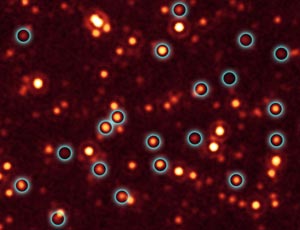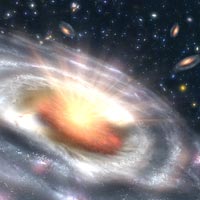The massive black holes, which continue to grow, were discovered by NASA's Spitzer and Chandara space telescopes, and they surround a significant portion of the black hole population that has so far gone unnoticed by researchers
Astronomers recently discovered hundreds of black holes hiding inside dusty galaxies billions of light years away.
The massive black holes, which continue to grow, were discovered by NASA's Spitzer and Chandara space telescopes, and they encompass a significant portion of the black hole population that has so far gone unnoticed by researchers. Discoveries indicate the existence of hundreds of millions more black holes that grew in the early universe, more than twice the number known at these distances.

In the image taken by the infrared cameras of the Spitzer Space Telescope, some of those black holes are visible, located deep within distant massive galaxies.
"Active supermassive black holes were found everywhere in the early universe," says Mark Dickinson of the National Astronomical Optical Observatory in Tucson, Arizona. "We have seen only the tip of the iceberg so far in our search for these objects, now we can see the iceberg itself" says Dickenson, one of the co-authors of two new articles that will appear in the November 10th issue of the Astrophysical Journal together with Emmanuel Dady of the French Atomic Energy Commission.
The findings also provide the first evidence that most, if not all, massive galaxies in the early universe spent their youth building the dreaded black holes at their cores.
For decades this large population of active black holes was thought to be absent. Their highly energetic structure belongs to a class of black holes known as quasars. A quasar consists of a plume-like cloud of gas and dust that surrounds and feeds the black holes, a process during which X-rays are emitted. These X-rays can usually be detected as a background glow in the sky. However, the quasars themselves are often not directly visible because the dust and gas block them from our view.
"We knew from other studies conducted in the last thirty years that there must be more quasars in the universe, but we didn't know where to look for them until now," says Dadi.
Dadi and his team initially wanted to study about a thousand dusty giant galaxies that are in the stage of star birth and that were thought to be absent quasars. The mass of these galaxies is similar to the mass of the Milky Way but their shape is irregular like the shape of the Milky Way. At a distance of 9-11 billion light years we see them at the time when the universe was in its adolescence - between 2.5 and 4.5 billion years.
When the astronomers dug closer into these galaxies using Spitzer's infrared vision, they noticed that over 200 of the galaxies emitted an unusual amount of far-red light. X-ray data from the Chandra Space Telescope and a technique known as "stacking" revealed that the galaxies actually hid quasars within. The scientists now believe that the quasars heated the dust around the Galactic Cloud, and it is this process that is responsible for the extra infrared light.
"We have found most of the vanishing quasar population in the early universe." Dadi said. Previously, only the rarest and most energetic of those hidden black holes had been seen at such an early age.”
The new quasars help answer fundamental questions about how massive galaxies evolved. Astronomers also learned that most massive galaxies build their stars and black holes at the same time, until they become too large and their black holes suppress the formation of new stars.
The observation also suggests that collisions between galaxies may not play as big a role in galaxy evolution as previously thought. "Theorists thought that mergers between galaxies were required to activate the quasars, but now we see that quasars can be active in galaxies that have not undergone any violent process." says David Alexander from the University of Durham in the UK, he is also a partner in the research.
"It's like the blind studied an elephant in the past, and we weren't sure which animal we had in our hands," added David Elbaz, also from the Committee for Atomic Energy in France. "Now we see the elephant for the first time".

The new observations were made as part of the Deep Study of the Early Universe, the most sensitive multiwavelength survey of the early universe to date. Consistent results for these studies were also obtained in other recent studies such as that of Fabrizio Fiora of the Astronomical Observatory of Rome, and his team. The results of their research will be published in an article on January 1, 2008 in the Astrophysical Journal.

2 תגובות
Just from the discoveries of the last year, which is influenced by black holes and dark matter, it seems to me that, at least regarding the existence of black holes, the agreement is wide in the world of science and also for enthusiasts like us!
In fact, it turns out that black holes are much more common than they thought at first and even more than their predicted rate in the future as this year shows!
This year can be called the year of the black holes that took center stage without which we probably wouldn't exist!
I'm waiting to hear when the black holes will be defined as the internal engines of the galaxies and who knows maybe as "wisdom" databases (according to my perception the stars think and decide... of course with astronomical powers) in enormous powers and volumes to "manage" the galaxy for all its billions of stars!
See black holes?
Photographed black holes?…
All this is misleading. You can't see black holes!
It may be possible to indirectly conclude that certain phenomena arise from the reality of black holes. But usually the above phenomena can also have another explanation.
Sabdarmish Yehuda